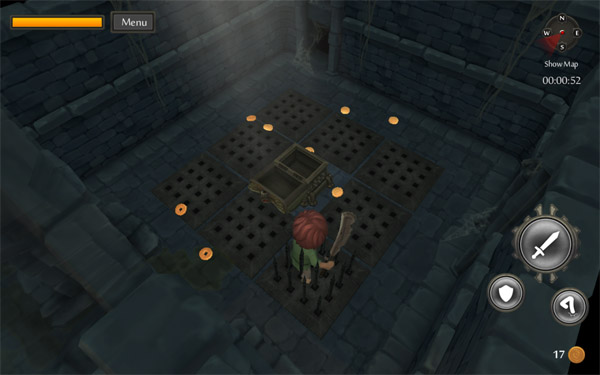
Awakening in a darkened cell in the corner of a dungeon, its labyrinthine passages twisting away before you into the unknown, you find a note from Maggie, your absent cellmate. She leads the effort to help your avatar escape Pershdale Dungeon, leaving notes of advice at the start of each level. In joining her you’ll have to battle hordes of ever more challenging enemies, gritting your teeth against powerful gatekeepers, pray for useful upgrades and discover surprising new traps and secrets, while hoping things don’t get too hectic. Though some may not have the patience to accept its quirks, fans of dungeon crawlers and roguelikes will be more than satisfied by this smallish mobile RPG that sports fine graphics, several compelling mechanics and a wealth of solid content.
We’ll begin with traps as they dominate the dungeon, literally lining the walls. There are as many as you’d expect to find in a dungeon crawling roguelike, such as spike traps and darts, with more hidden in the scenery. The ability to knock over braziers and cook monsters is a particularly enjoyable addition.
The possible contents of a level depend on which floor you’re on. Each procedurally drawn dungeon level can be built around one of a variety of themes, each with its own set of rooms, traps and enemies. The first three have a traditional dungeon look with flagstone passageways, bats in the walls and prisoners who can be freed to help, hinder or amuse you. The following three levels replace these more traditional dungeon trappings with towering trees, strange monoliths, booby-trapped trellises and crawling vines. There also happens to be an invincible golem that will stalk the player across a level, sending them across the room with its attacks.
Combat is basic, often devolving into a repetitive block-then-counter pattern. Successful blocking requires you to almost directly face your assailant and the limited range of protection leaves you vulnerable to attacks from anywhere but the front. This can make for very one-sided fights with multiple enemies, driving you into a corner with no option but to drop your guard and hope you can get an attack in first. Opposing factions, such as orcs and skeletons, will fight each other and enemies will actually slaughter their beastly comrades in a bid to reach you, which savvy players will of course exploit to their benefit. Traps too can play a vital role, with players able to lure monsters into them, either killing them outright or pinning them so they’re easier to attack. This provides for a more reliable method of disposing of enemies than the alternative block, swing, pray method, although not all of them are susceptible to every trap. Traps degrade with use and eventually break, sometimes even when they’re first triggered, and weaker ones, like the floor spikes, will simply be destroyed by large monsters such as golems and bosses. This introduces an enjoyable element of planning to the game, encouraging players to scout out the best routes to lure strong enemies down while attempting to preserve their pristine condition as they clean up lesser minions. 
Although there are several weapons to be found throughout the game, they’re secret items, so most of stat boosts come in the form of upgrades. Prisoners can be upgraded with the use of shrines, which accept offerings of gold in exchange for bestowing random enhancements. There are two main types of shrines to be found, one that costs 15 gold coins and another that goes for 100. The cheaper shrine is always located just before the exit, and is inaccessible before a levels objective has been completed. They can provide several new skills such as a chance to dodge arrows or land critical hits, and upgrade stats such as health, movement, and attack speed that can thankfully all be stacked. The shrines that require 100 gold pieces are randomly placed somewhere within each level, and always in their own rooms. Instead of stat upgrades they bestow abilities like blocking magical projectiles or doubling the value of gold coins. Finally, there are several special shrines located in later levels that bestow powerful weapons or unlock secrets areas for even larger amounts of gold. Shrines activate when approached, which can prove an annoyance at times, forcing you to throw gold from your pockets as you pass while you’re pursuing a fleeing archer. Even though gold isn’t used for anything else it can be really unnerving to lose a stack or two in this way, especially if you were saving for a different tier of upgrades or for a powerful weapon.
It is a roguelike, and sometimes the hand you’re dealt will crush you quickly. But then there will be times when you fly through a level, finding your sword and shield in seconds, coming across a chest of gold on the first floor, and receiving your favorite upgrade in another. New games can be started from any previously reached level. Unfortunately, the game automatically loads the first floor of the dungeon when you die. It can’t be canceled or skipped, which means you have to quit out and restart the game if you don’t want to play through from the beginning. It’s not a deal breaker, but it does start to feel like a form of punishment after a while.

Tiny Keep can also become very resource-intensive, slowing down at busy times when the screen is full of fires and explosions, and low-powered devices will definitely suffer lag when the screen’s filled with multiple enemies. The touch controls tend to stick, especially when turning. However, Bluetooth controllers are supported, and can help provide for a much smoother experience.
At the end of the day, however, most players will weather the occasional slowdown, if the game is worth your time. And if you’re a fan of dungeon crawlers Tiny Keep is worth your time. It’s a roguelike that does roguelike well; and compelling mechanics like environmental manipulation just serve to sweeten the deal . What’s more, there’s a lot of content on offer, including secret weapons and pets, which rewards players who invest the time to discover Maggie’s fate. This is not to say this is God’s gift to roguelikes. It’s not. For certain the occasional glitch or slowdown is a deal killer for some, but we venture not most. Tiny Keep does have its flaws and annoyances, but overall it is an enjoyable and well-built game that brings some interesting ideas to the dungeon crawling genre.
Hardcore?
Yes.
A solid, stylish rogue-like with some interesting feature and a lot of content, but it might struggle on slower devices.


























